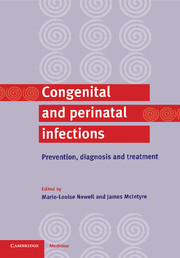Book contents
- Frontmatter
- Contents
- List of contributors
- Preface
- Part I General issues
- Part II Specific infections
- 5 Rubella infection in pregnancy
- 6 Perinatal Group B streptococcal infections
- 7 Mother-to-child transmission of cytomegalovirus
- 8 Varicella
- 9 Herpes simplex
- 10 Vertical transmission of hepatitis viruses
- 11 Papillomavirus infections as a perinatal problem: diagnosis, prevention and management
- 12 HIV-1 infection
- 13 Syphilis: prevention, diagnosis and management during pregnancy and infancy
- 14 The other sexually transmitted diseases
- 15 Toxoplasmosis
- 16 Neonatal sepsis
- Index
14 - The other sexually transmitted diseases
Published online by Cambridge University Press: 06 July 2010
- Frontmatter
- Contents
- List of contributors
- Preface
- Part I General issues
- Part II Specific infections
- 5 Rubella infection in pregnancy
- 6 Perinatal Group B streptococcal infections
- 7 Mother-to-child transmission of cytomegalovirus
- 8 Varicella
- 9 Herpes simplex
- 10 Vertical transmission of hepatitis viruses
- 11 Papillomavirus infections as a perinatal problem: diagnosis, prevention and management
- 12 HIV-1 infection
- 13 Syphilis: prevention, diagnosis and management during pregnancy and infancy
- 14 The other sexually transmitted diseases
- 15 Toxoplasmosis
- 16 Neonatal sepsis
- Index
Summary
Introduction
This chapter discusses aspects of five reproductive tract infections (RTIs) on maternal and infant health. The five RTIs considered are gonorrhoea, chlamydial infection, genital mycoplasma infection, trichomoniasis and bacterial vaginosis. These infections are very common in resource-constrained settings and are the cause of significant morbidity for women and their children. Syphilis and HIV are discussed in other chapters.
Neisseria gonorrhoeae infection in pregnancy
Epidemiology
Globally, the prevalence of gonococcal cervical infections in pregnant women varies widely geographically (Table 14.1). In Western Europe and Canada, the prevalence of gonorrhoea in pregnant women is very low. In the USA prevalence in pregnant women varies widely. In sub-Saharan Africa, Asia, Latin America and the Caribbean, gonococcal infection prevalence rates in pregnant women and family planning clinic attenders vary widely, but are also much higher than in industrialized areas. Overall, the burden of gonococcal infection in developing countries is increasing due to its rising prevalence and to the increasing cost of treatment, after the widespread emergence of resistance to inexpensive antibiotic therapy (Ison et al., 1998).
Risk factors for gonococcal infection appear to be the same in pregnant as in non-pregnant women. Studies in North America have shown that individuals with the highest rate of detected gonorrhoea live in urban areas, are young, non-white, unmarried, of low socio-economic status and with a prior history of gonorrhoea (Barnes & Holmes, 1984).
- Type
- Chapter
- Information
- Congenital and Perinatal InfectionsPrevention, Diagnosis and Treatment, pp. 276 - 304Publisher: Cambridge University PressPrint publication year: 2000

